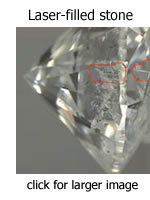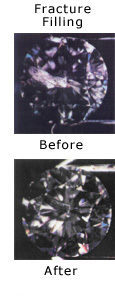Diamond Treatments
All diamonds must be processed in order to be used in jewelry. They must, for example, be cut and polished. Other enhancements are usually applied to diamonds to bring out the gem's inherent beauty. These processes do not camouflage flaws or harm the stone in any way.
Treatments, on the other hand, are done to stones of lower quality to make them appear more attractive. If such treatments were not disclosed, a customer would believe the gem to be more valuable than it is and might be led to pay too high a price.
Treatments that are not accepted as part of the usual processing of diamonds should always be specifically disclosed, both verbally and on the sales papers and appraisal.
The Gemstone Enhancement Manual is the jewelry industry's standard reference for gem treatments, and we have relied on it for assessing gem treatments. However, with the increasing market for diamond jewelry, new treatments are always coming out. Not all of them have been around long enough to be tested for durability and stability. We will keep this site as current as possible with information about new treatments.
Treatments That Should Be Disclosed
Laser Drilling
 An
inclusion in a gem (usually of some other gem material) shows up as an imperfection.
In this treatment, a microscopic channel is drilled to the imperfection and
an acid is injected into the foreign material to bleach it and make it less
visible. The inclusion becomes less apparent but it is still present.
An
inclusion in a gem (usually of some other gem material) shows up as an imperfection.
In this treatment, a microscopic channel is drilled to the imperfection and
an acid is injected into the foreign material to bleach it and make it less
visible. The inclusion becomes less apparent but it is still present.
Laser drilling is controversial within the jewelry industry, and not all jewelers believe the treatment needs to be disclosed. However, a laser-drilled diamond has a lower value than one of similar appearance that has not been laser-drilled. If the treatment is not disclosed, you could be paying considerably more than the jewelry is worth.
Coating
Diamonds are occasionally coated to disguise a low color grade, or to produce "fancy colors". The stability of the treatment varies, depending on the method used. Coated stones require special care, because subsequent cleaning or recutting may harm the the appearance of the stone.
 Fracture Filling
Fracture Filling
Surface-breaking cavities or internal fractures are filled with some foreign substance to improve the appearance of the gem. The treatment makes an inferior gem look clearer (to the unaided eye) and hence appear more valuable.
Literally thousands of materials are used to fill fractures. The composition of the filling material in any particular stone is unknown, and its durability and stability have not been studied.
Extreme heat from cleaning, or pressure from recutting or resetting the stone, may cause the fracture-filling treatment to break down. The gem will then appear to have become damaged, but really it is just the original character of the stone becoming visible.
Yehuda Clarity Treatment
A colorless resin is injected into a diamond to greatly improve its appearance. Yehuda treatment is a kind of fracture filling. Unlike many other treatments, it is not readily detectable and makes a stone of lesser value appear to be of much higher quality. Heat may damage the treatment.
Irradiation
This is done to poor quality stones to make them resemble expensive "fancy colored" diamonds. The treatment is quite stable except for green stones, which may change color when heated.
GE/POL Color Treatment / Monarch
Lazare-Kaplan International, in partnership with General Electric, is marketing off-color diamonds that have been treated so they appear to be colorless. The treated diamonds are inscribed "GE POL" on the stone's girdle. (The inscription is visible only under 10-power magnification.) However, this inscription can be removed. If that happens, the treated stones would be not be easily recognized. These treated diamonds are being test-marketed under the name Monarch. (You may also hear the term Pegasus diamond. The POL in the inscription stands for Pegasus Overseas Ltd., a Lazare-Kaplan subsidiary.) The lab feels the treatment is permanent, but there is not yet any independent verification of this claim.
According to reports in March 2000, the same heat-and-pressure treatment used to make brownish diamonds colorless can also be used to make fancy colored diamonds. GE/POL has plans to market these diamonds as well.
EGL/NovaDiamond Color Enhancement
The European Gemological Laboratory recently unveiled a process to color-enhance low quality brown diamonds into fancy green and yellow colors. The treatment involves high pressure and high temperature. NovaDiamond plans to sell the gems primarily on the internet and to select retailers. Eventually the company intends to produce other colors, including blues and pinks. The lab feels the treatment is permanent and irreversible, but there is not yet any independent verification of this claim.
Shopping Considerations and Caveats
- If the retailer does not volunteer information on treatments, ask whether the stone has been treated or enhanced in any way. If he names a treatment you do not understand, ask for an explanation. Ask the purpose of the treatment and whether the treated stone requires any special care. You may choose to buy a less expensive treated gem over a higher priced untreated gem, but you should have all available information before making a purchasing decision.
- The GE-POL treatment, discussed above, is being described by its labs as a "process" rather than a "treatment." The terminology is to suggest that, if it isn't a treatment, it needn't be disclosed. But this IS a treatment and it should be disclosed.
- Remember that the purpose of any treatment is to make the stone appear more attractive than it is naturally. Disclosure ensures that you are not paying the price of a high quality gem but receiving a lower quality stone in disguise.
 Buyer's
Tip
Buyer's
Tip
The bill of sale should state all treatments given the diamond. If the diamond has not been treated, the sales receipt should state that it is untreated.
Four Cs of Diamonds
Comparison Shopping
